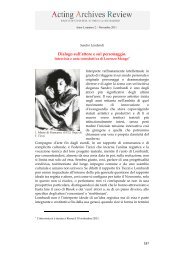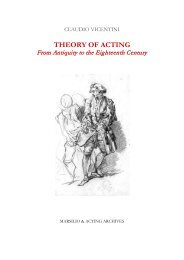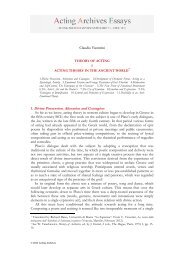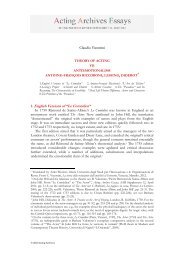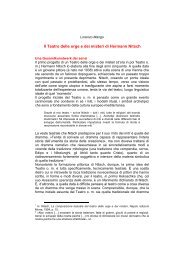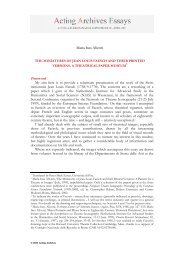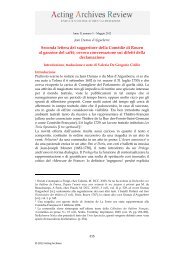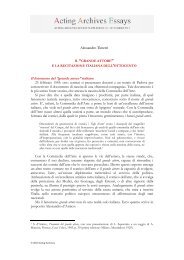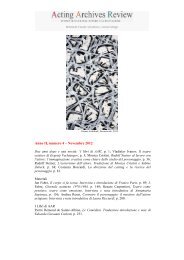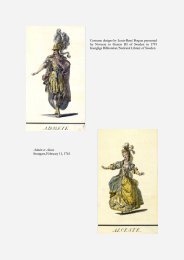Flavia Pappacena_Noverre's Lettres sur la Danse - Acting Archives
Flavia Pappacena_Noverre's Lettres sur la Danse - Acting Archives
Flavia Pappacena_Noverre's Lettres sur la Danse - Acting Archives
Create successful ePaper yourself
Turn your PDF publications into a flip-book with our unique Google optimized e-Paper software.
AAR <strong>Acting</strong> <strong>Archives</strong> Essays Supplement 9 – April 2011<br />
‘Appendix’ at the end of the present essay). It is a summary of his aesthetic credo,<br />
together with a series of previously unpublished annotations concerning costumes.<br />
Noverre’s Reform in the Context of Changing Taste in Mid-Eighteenth<br />
Century France<br />
Although the 1803-04 and 1807 editions give a comprehensive account of the<br />
author’s approach, with an overview of all his activity, it was the work he published<br />
in 1760 that left its mark on the history of dance. The numerous endorsements he<br />
received over the next few years showed that the time was indeed ripe for a major<br />
reform; both Louis de Cahusac and Diderot had recently remarked that dance had<br />
long been awaiting a man of genius, able to point the way. 3 Even in the hidebound<br />
milieu of the Opéra de Paris where, as Charles Burney was to remark, time seemed to<br />
have come to a standstill, there had been some signs of renewal, as Noverre was<br />
forced to recognise, following in the footsteps of Marmontel and Cahusac. 4 ‘<strong>Danse</strong>s<br />
épisodiques’ had been introduced into operas and opéras-ballets in an attempt to<br />
contrast the irrelevance of the ballets to the action taking p<strong>la</strong>ce on stage, reintegrating<br />
dance into the drama. 5 While such iso<strong>la</strong>ted episodes did not mark a fundamental<br />
change at the Opéra itself, for some time the Comédie-Italienne, the Comédie-<br />
Française and the Opéra-Comique – to speak only of the situation in Paris – had<br />
been in the throes of ferment, with innovatory proposals being advanced by Jean-<br />
Baptiste François De Hesse, Pietro Sodi, Antoine Pitrot and Jean-Baptiste Hus. 6<br />
These proposals aimed at the gradual stylisation of the pantomime deriving from the<br />
3 See Louis de Cahusac, La danse ancienne et moderne ou Traité historique de <strong>la</strong> danse, La Haye, Jean<br />
Neaulme, 1754, II, Book IV, chap. VII, p. 235 (repub. ed. by N. Lecomte, L. Naudeix and J.-N.<br />
Laurenti, Paris, Desjonquères/Centre National de <strong>la</strong> <strong>Danse</strong>, 2004). See also Denis Diderot, Entretiens<br />
<strong>sur</strong> le Fils naturel (1757), in Œuvres complètes, ed. by J. Assézat, Paris, Garnier, 1875-1877, t. VII, p. 157.<br />
4 Cf. Charles Burney, The present state of music in France and Italy, or the journal of a tour through those<br />
Countries, undertaken to collect Materials for a general History of Music, London, T. Becket and Co., 1773, pp.<br />
28-36.<br />
5 In the article ‘Pantomime’ deals above all with the integration of dance into opera and cites as<br />
successful examples Le Ballet des Bergers in the opera Ro<strong>la</strong>nd, Le Ballet des armes d’Énée in Lavinie,<br />
and in the same opera Le Ballet des Bachantes, Le Ballet de <strong>la</strong> Rose in Les Indes ga<strong>la</strong>ntes, Le Ballet des<br />
Lutteurs for the funeral of Castor (see Jean-François Marmontel, Œuvres complètes, Paris, Née de La<br />
Rochelle, 1787, tt. V-X, Éléments de Litterature; repub. ed. by S. Le Ménahèze, Paris, Desjonquères,<br />
2005, p. 844). As specimens of ‘danse épisodique’ integrated in the action Cahusac cites l’enchantement<br />
of the false Oriane in Amadis; the Passacaille included by Marie Sallé in L’Europe ga<strong>la</strong>nte; Le Pas des<br />
Lutteurs in Les Fêtes grecques et romaines (see Louis de Cahusac, La danse ancienne et moderne ou Traité<br />
historique de <strong>la</strong> danse, II, Book IV, chap. 11, pp. 235-238). Noverre in Letter VII (1760) cites l’Acte des<br />
Fleurs, the act of Eglé in Les Talents lyriques, the Prologue to Les Fêtes grecques et romaines; the Turkish act<br />
in the old opéra-ballet L’Europe ga<strong>la</strong>nte and ‘one act among many from Castor et Pollux’ (1760, Letter VII,<br />
p. 126; Beaumont, p. 54). This, like the following citations of the 1760 text, comes from the<br />
trans<strong>la</strong>tion made by Cyril W. Beaumont, published in London in 1930 and frequently reprinted. The<br />
volume contains the 15 letters of 1760 but in the corrected, integrated version of 1803 (volume I,<br />
tome II). The page numbers refer to the reprint of 1968 (see ‘Appendix’ at the of the present essay).<br />
6 On this topic see in particu<strong>la</strong>r: C<strong>la</strong>ude and François Parfaict, Dictionnaire des théâtres de Paris, 7 vols.,<br />
Paris, Rozet, 1767-1770 (facsimile Genève, S<strong>la</strong>tkine Reprints, 1967), and M. H. Winter, The Pre-<br />
Romantic Ballet, London, Pitman, 1974.<br />
2



